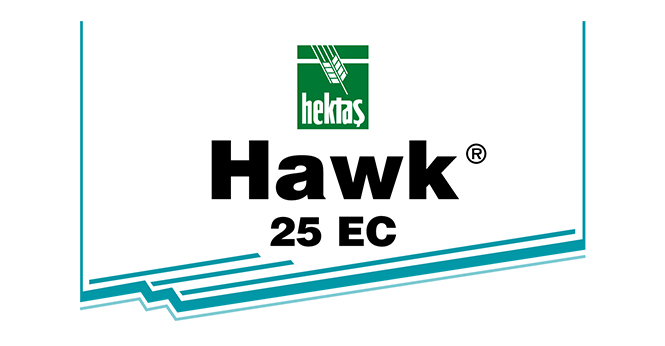
HAWK® 25 EC
Active Ingredient: 25 g/l Beta-cyfluthrin
Formulation : EC (Emulsion concentrate)
Packaging : 1lt, 500 ml
Specifications
A synthetic pyrethroid insecticide with rapid and long-term effect. It has a wide spectrum of action.
Method Of Application
Sunn pest: When the sunn pest falls down the fields, some counts and assessments are made in the fields. As a result of this, it is decided for chemical management.
Cereal weevil: Spraying is made 10 days after leaving the soil (Stem rising period).
A spraying against pistachio psyllid should be carried out when 20-30 nymphs are seen per compound leaf per week; when the majority of eggs are open and before the first mature parasitoid emergence and the sticky layer (fumagine) on the leaf surface.
Against black scale on olive: The time of administration is detected according to emergence of active larvae, in the gardens where spraying will be made for this purpose, the eggs of that year placed on the shoots of 20-25 cm tall from four sides of the number of trees to represent the garden are inspected and emergence of active larvae from egg is detected. 1st administration is made in the period when 50% of the eggs are open, 2nd administration is made when 90% of them are open.
Olive fruit fly: The dents are made in the period when the fruit reaches the maturity of laying eggs, in case of sufficient dents and increase in the number of mature olive insect caught in the shoots, administration is started.
Olive moth: Administration is not recommended in flower progeny of pest. However, when there is more than 10% pest in leaves and new shoots at the beginning of the season when the product is low, 7-10 days after catching the first butterflies in the flower progeny, an administration is made to the flower progeny. Preferably, administration should be made only against fruit fertilization. Administration is made when 10% of the lentil-sized fruits that are inspected live “egg + larvae”.
Tomato: For management of aphids, the field is entered diagonally and leaves are taken randomly at every 3-5 steps to determine the number of pests per leaf. Management should be started when the pest count per leaf is 10-20. However, the activity of beneficial insects should be considered before deciding on spraying, observing parasitoids and predators.
Spraying against apple green aphid should be carried out when 15/100 offshoots are contaminated.
Corn: The first spraying is done after the first eggs of the pest are seen, followed by 2nd and 3rd sprayings done at 15-day intervals.
Against potato beetle; when it reaches 14-15ᵒC in average daily, the field is entered from the direction of diagonals and eggs, larvae and matures of pest are sought in seedbeds. Seeing in any period indicates that that field is contaminated. If administration will be made against 1st progeny, it should be made when the first mature larvae are observed in the plants (4th period). For the administration to 2nd progeny, completion of egg opening should be waited. In this period, the damage that can occur depending on density of insect may not required administration since it is tolerated by the plant. However, as a result of the researches, 20% damage caused by the potato insect on the leaves of the potato plant can be tolerated by the plant and there is no decrease in the product. This rate can increase up to 40% depending on phenological period and development of the plant.
Compatibility: Cannot be mixed with alkaline pesticides. However, a trial mix should be done before mixing with other products.
